BestReviews is reader-supported and may earn an affiliate commission. Details
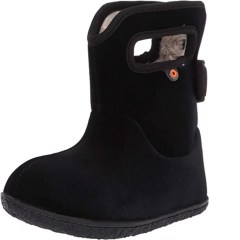
Good price for a boot with handles that allows older toddlers to practice putting on their shoes.
Waterproof material blocks wet snow and even rain. Rubber sole encompasses base of boot, adding stability while faux fur inside shoe keeps child’s feet warm and dry.
Some of the other colors aren’t made from the same material.
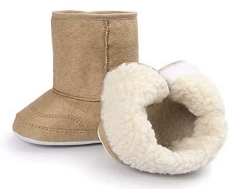
A stylish boot at a super price.
A fantastic choice for infants who haven't begun to walk yet. Available in different colors and sizes. Sole is anti-slip and the interior is lined with warm wool-like fabric.
Some had difficulty figuring out the right size for their child.
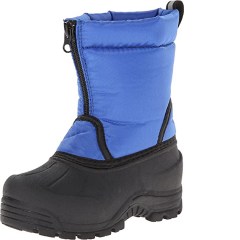
A snow boot showcasing superior weather performance and trendy design.
Zippered pull-down design for easy on and off. Several color options available. Textured sole offers supreme grip and functionality.
Seams may tear over time.
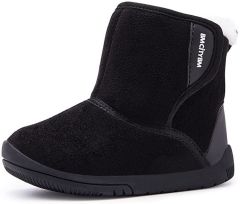
Great price for a warm winter boot.
Non-slip sole provides superior traction, and the fluffy fabric keeps toes toasty warm. This snow boot also offers extra protection for toes with the rubber toe cap.
Stiff heal makes it hard to put on sometimes.
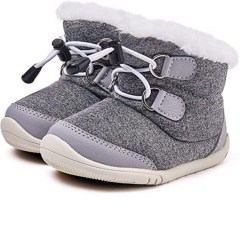
The flexibility of this sturdy, unisex infant snow boot encourages baby to crawl or walk freely.
This snow boot features the best of both worlds with a faux fur lining and all rubber soles. Secure the boots with adjustable elastic toggle laces.
Some buyers said that the sizing is not accurate.

We recommend these products based on an intensive research process that's designed to cut through the noise and find the top products in this space. Guided by experts, we spend hours looking into the factors that matter, to bring you these selections.

In snowy weather, toddlers and kids need some good snow boots. The boots should keep their little feet warm, fit correctly, be easy to put on and take off, have good tread, and come with waterproof soles. It wouldn’t hurt if they came in a color and design your kids enjoy, too.
It’s hard to ask a youngster if the boots on their feet meet all of the above criteria, especially if the little one is still a baby or even a toddler. It’s up to you, the adult, to shop wisely and buy something that ticks all the boxes. Playing in the snow is supposed to be fun; the last thing you want is a tearful child with freezing toes and cold snow in their boots. Don’t worry; we’ve got you covered.

Most boots are made of at least two different materials: one for the soles and another for the rest of the boot. The soles are almost always made of rubber or a rubber byproduct, while the rest of the boot is usually made of a synthetic material such as quilted or padded nylon. Other materials could include textiles, suede, and leather. Leather boots are breathable and extremely durable; it’s not unusual for them to last 5 to 10 years. The downside is that leather is initially quite stiff and requires a lengthy break-in period. During that period, it is common for people to develop sores and blisters where their feet rub against the leather.
There’s no breaking-in period required for boots made of synthetic materials. They won’t last nearly as long as leather, though, and some synthetic materials aren’t as breathable as leather. If you’re buying boots for a child, however, you might not be concerned about their long-term durability, as most kids need a new boot size every year during their growing years.
Children grow rapidly, and you might be tempted to buy the next larger size in anticipation of them “growing into” the boots over time. We advise you not to do that.
Boots that are too big will be easy for your toddler or small child to walk out of should the boots get stuck in wet, heavy snow. Furthermore, boots that are too big have a larger gap at the top, and it’s far easier for pesky snow to slide into them, annoying your youngster.
Measure your child’s feet, and pay close attention to the sizing chart when you’re buying snow boots. Each manufacturer may have a slightly different way of sizing their boots, so don’t assume that a size six for one brand would fit the same as a size six for another brand. A little extra time up front will save you a lot of time and money later on.
Toddlers and young children need snow boots that are easy to put on and take off. Boots that are difficult in this regard will cause you undue stress, whether you’re the one dressing the child or the one listening to the child as they struggle.
The main issue, aside from size, is the closing and opening of the boot. There are some variations available.
Velcro closures are also known as hook-and-loop systems. The rough side of the Velcro is called the hook. The soft side is called the loop. Velcro closures are easy to open and close. They can be pulled tighter to hold the boot more securely or loosened to let the boots breath. For toddlers and young children, Velcro is a fantastic solution.
Boots with zippers are convenient, too. Zippers are usually pretty easy for kids to operate. The primary difficulty with zippers is one that adults often experience, too: the cloth or fabric beside the zipper can sometimes get caught in the teeth, leading to a zipper jam. You might want to supervise children when they’re putting on boots with zippers, even when they want to do it themselves.
Boots with laces are the hardest for small children and toddlers to master. Often, young kids don’t have the manual dexterity or strength to properly fasten and secure laces on their sneakers, let alone their snow boots. Trying to re-tie the boots when you’re already out in the snow can become a major headache.
In many cases, simplicity is best. Choose the easiest closure system possible for the least amount of struggle.
Although many boots claim to be waterproof, the only part you can actually count on for that is the rubber sole. The rest of the boot may only be water-resistant. In most cases, you’ll have to get a waterproof spray that you can treat the boots with before going outside.
Toddlers and young children need good tread on their boots. The deeper the tread, the more traction they’ll have, and the less likely they will be to slip and fall in icy conditions.
Here is where you’ll see an explosion of choices. Some manufacturers provide as many as 25 possible color and pattern combinations. Unless it’s a gift, consider involving your child in the color and design choice. Your child will feel a sense of ownership and will be more likely to put on the boots willingly.
Wool socks: Yoicy Baby Toddler Thick Wool Socks
Boots alone aren’t enough to keep your toddler’s feet warm. You need some thick socks, too. We like these wool socks from Yoicy; they come in blue, brown, and pink to fit every style.
Boot dryer: JobSite Original Shoe Boot Dryer
When your toddler’s boots get wet, dry them off with this boot dryer from JobSite. It dries soaking wet boots over the course of one night and damp boots within eight hours. You can also use this appliance to warm up boots half an hour prior to putting them on.
The least-expensive snow boots for young children cost $10 or less. These boots are mostly intended to keep the child’s feet warm while you carry them or keep them in a stroller. They’re not hardy enough to withstand a trek through the snow.
The medium price range for snow boots is between $10 and $40. These cover a wide assortment of good snow boots, mainly for younger children. Above $40, you’ll find extremely rugged snow boots for children who will be playing in the snow for extended periods of time.

Q. What is the best lining for my children’s boots?
A. Fleece, made of polyester or another synthetic material, is a lining material, but it is often expensive. Faux fleece, made of cotton or tufted nylon, is the next best thing.
Q. Can I get snow boots for my children that have buttons?
A. There are a few snow boots available with buttons, but think carefully before selecting this type of boot. For buttons to be effective on snow boots, they have to be big and sturdy. This can make them difficult for small children to handle.
Q. How accurate are the temperature ratings on kids’ snow boots?
A. There are no guarantees here. You should remember that snow boots are tested on the assumption that your child will be wearing the right type and number of socks. If your child is only wearing one pair of thin dress socks with their snow boots, their feet are going to get cold no matter what temperature rating the boots have.
Get emails you’ll love.
Learn about the products you’re wondering if you should buy and get advice on using your latest purchases.
